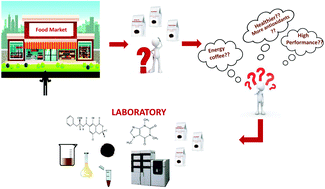Contents of key bioactive and detrimental compounds in health performance coffees compared to conventional types of coffees sold in the United States market†
Abstract
The United States is the largest coffee consuming country worldwide. Recently, in addition to cup quality, the focus on health promotion has increased significantly in the country, with launching of many brands with health claims, mainly highlighting the antioxidative and stimulating properties of the beverage. On the other hand, mycotoxins and, to a lesser extent, acrylamide, have raised concerns among consumers and health authorities. This study investigated the contents of the main bioactive compounds (caffeine, chlorogenic acids and their 1,5-γ-quinolactones, and trigonelline) in health performance coffees and compared them to those of conventional roasted coffees available on the U.S. market. The following categories were compared by ANOVA at p ≤ 0.05, followed by Fisher's test: 1 – health performance, 2 – gourmet and 3 – traditional, totaling 127 samples. As complementary results, the contents of acrylamide and ochratoxin A were evaluated in part of the samples (n = 58). The mean contents (g per 100 g) of bioactive compounds for categories 1 to 3, respectively, were 1.09, 1.11 and 1.07 for caffeine; 1.75, 1.88 and 1.34 for chlorogenic acids/lactones, and 0.63, 0.64 and 0.56 for trigonelline. The mean contents (μg kg−1) of acrylamide for categories 1 to 3, respectively, were 82, 71 and 85. Only about 7% of the evaluated samples presented quantifiable amounts of OTA and all of them were within the maximum limits established by health authorities. In general, the contents of bioactive and potentially harmful compounds were not consistently different among categories, with high and low individual amounts in all of them. Most health claims on labels related to the amount of bioactive compounds in health performance coffees were unjustified, suggesting the need for improvement in coffee labeling regulation in the U.S.

- This article is part of the themed collection: Food & Function Recent HOT articles


 Please wait while we load your content...
Please wait while we load your content...